Reflection & Feedback: Orientation for Success in Higher Education
VerifiedAdded on 2023/06/08
|7
|1986
|57
Essay
AI Summary
This essay discusses the importance of reflective learning in higher education, emphasizing how it enables students to critically analyze their learning experiences and improve future performance. It highlights the Gibb's Reflective Cycle as a valuable tool for structuring reflection, covering stages like description, feelings, evaluation, analysis, conclusion, and action plan. The essay also underscores the significance of formative feedback from teachers and higher authorities in boosting student learning, enabling corrective actions, and improving assessment outcomes. Furthermore, it contrasts formative and summative assessments, explaining how both, along with feedback and feed-forward mechanisms, contribute to a student's overall academic growth and skill development. The conclusion reiterates that reflective learning, coupled with effective feedback, is crucial for students to identify problems, enhance skills, and achieve success in their higher education journey.
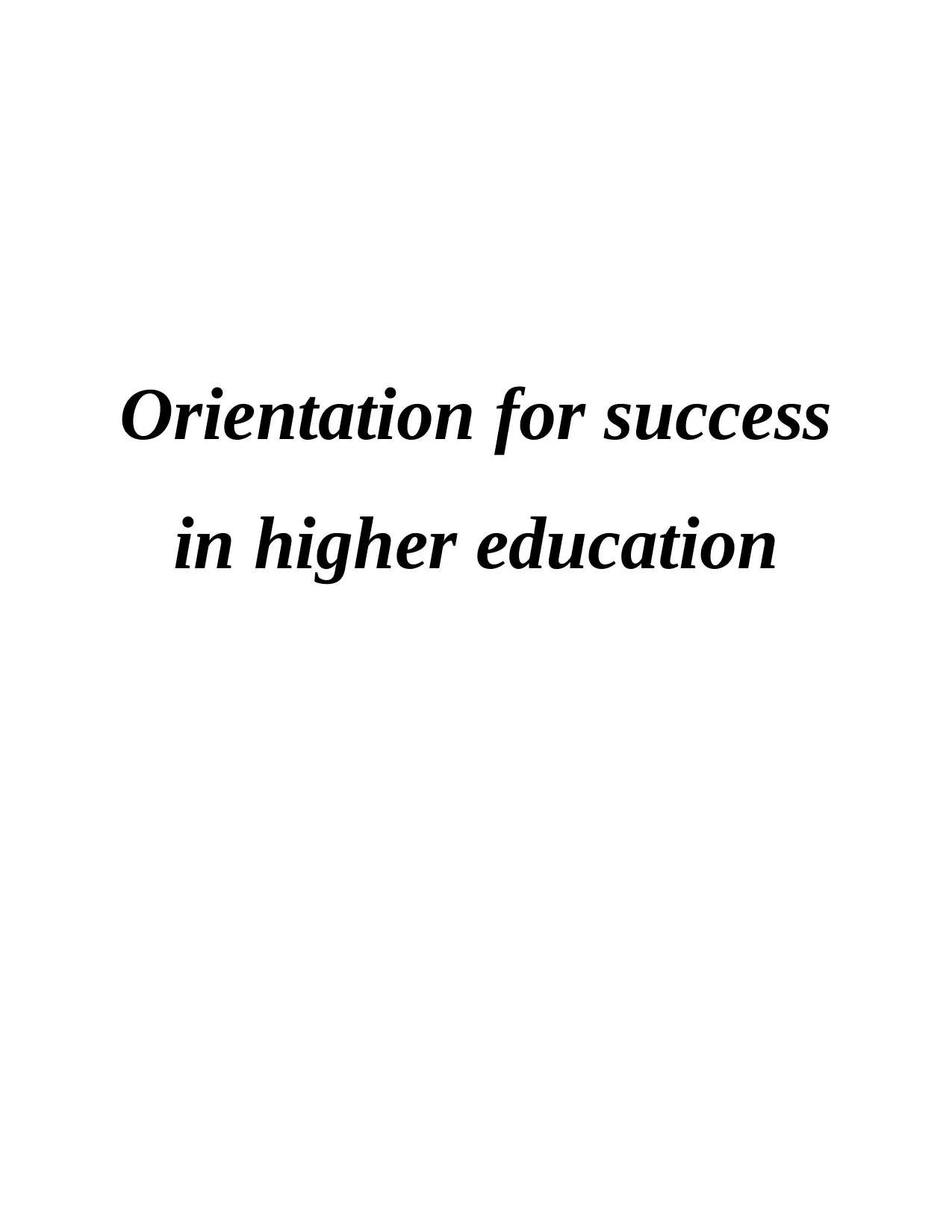
Orientation for success
in higher education
in higher education
Paraphrase This Document
Need a fresh take? Get an instant paraphrase of this document with our AI Paraphraser
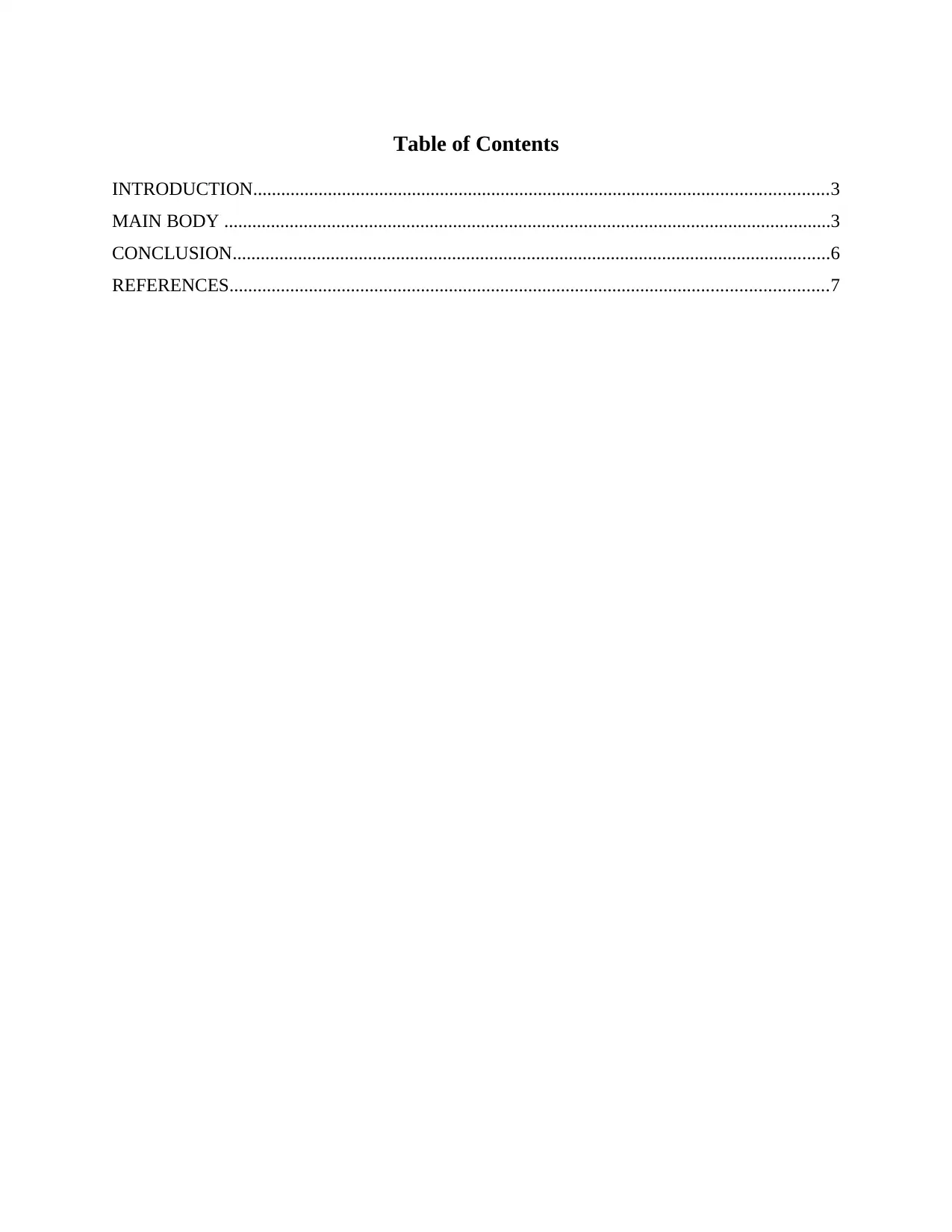
Table of Contents
INTRODUCTION...........................................................................................................................3
MAIN BODY ..................................................................................................................................3
CONCLUSION................................................................................................................................6
REFERENCES................................................................................................................................7
INTRODUCTION...........................................................................................................................3
MAIN BODY ..................................................................................................................................3
CONCLUSION................................................................................................................................6
REFERENCES................................................................................................................................7
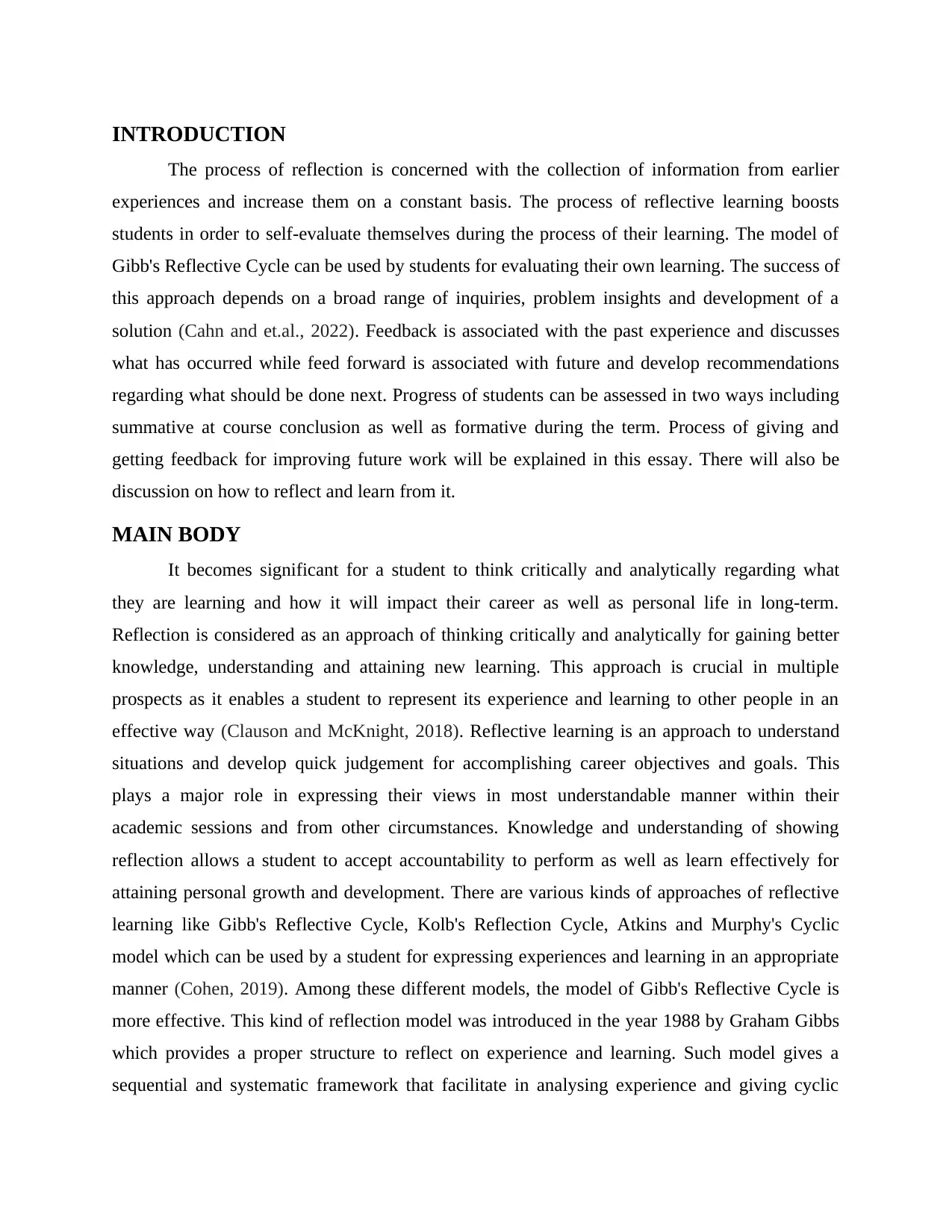
INTRODUCTION
The process of reflection is concerned with the collection of information from earlier
experiences and increase them on a constant basis. The process of reflective learning boosts
students in order to self-evaluate themselves during the process of their learning. The model of
Gibb's Reflective Cycle can be used by students for evaluating their own learning. The success of
this approach depends on a broad range of inquiries, problem insights and development of a
solution (Cahn and et.al., 2022). Feedback is associated with the past experience and discusses
what has occurred while feed forward is associated with future and develop recommendations
regarding what should be done next. Progress of students can be assessed in two ways including
summative at course conclusion as well as formative during the term. Process of giving and
getting feedback for improving future work will be explained in this essay. There will also be
discussion on how to reflect and learn from it.
MAIN BODY
It becomes significant for a student to think critically and analytically regarding what
they are learning and how it will impact their career as well as personal life in long-term.
Reflection is considered as an approach of thinking critically and analytically for gaining better
knowledge, understanding and attaining new learning. This approach is crucial in multiple
prospects as it enables a student to represent its experience and learning to other people in an
effective way (Clauson and McKnight, 2018). Reflective learning is an approach to understand
situations and develop quick judgement for accomplishing career objectives and goals. This
plays a major role in expressing their views in most understandable manner within their
academic sessions and from other circumstances. Knowledge and understanding of showing
reflection allows a student to accept accountability to perform as well as learn effectively for
attaining personal growth and development. There are various kinds of approaches of reflective
learning like Gibb's Reflective Cycle, Kolb's Reflection Cycle, Atkins and Murphy's Cyclic
model which can be used by a student for expressing experiences and learning in an appropriate
manner (Cohen, 2019). Among these different models, the model of Gibb's Reflective Cycle is
more effective. This kind of reflection model was introduced in the year 1988 by Graham Gibbs
which provides a proper structure to reflect on experience and learning. Such model gives a
sequential and systematic framework that facilitate in analysing experience and giving cyclic
The process of reflection is concerned with the collection of information from earlier
experiences and increase them on a constant basis. The process of reflective learning boosts
students in order to self-evaluate themselves during the process of their learning. The model of
Gibb's Reflective Cycle can be used by students for evaluating their own learning. The success of
this approach depends on a broad range of inquiries, problem insights and development of a
solution (Cahn and et.al., 2022). Feedback is associated with the past experience and discusses
what has occurred while feed forward is associated with future and develop recommendations
regarding what should be done next. Progress of students can be assessed in two ways including
summative at course conclusion as well as formative during the term. Process of giving and
getting feedback for improving future work will be explained in this essay. There will also be
discussion on how to reflect and learn from it.
MAIN BODY
It becomes significant for a student to think critically and analytically regarding what
they are learning and how it will impact their career as well as personal life in long-term.
Reflection is considered as an approach of thinking critically and analytically for gaining better
knowledge, understanding and attaining new learning. This approach is crucial in multiple
prospects as it enables a student to represent its experience and learning to other people in an
effective way (Clauson and McKnight, 2018). Reflective learning is an approach to understand
situations and develop quick judgement for accomplishing career objectives and goals. This
plays a major role in expressing their views in most understandable manner within their
academic sessions and from other circumstances. Knowledge and understanding of showing
reflection allows a student to accept accountability to perform as well as learn effectively for
attaining personal growth and development. There are various kinds of approaches of reflective
learning like Gibb's Reflective Cycle, Kolb's Reflection Cycle, Atkins and Murphy's Cyclic
model which can be used by a student for expressing experiences and learning in an appropriate
manner (Cohen, 2019). Among these different models, the model of Gibb's Reflective Cycle is
more effective. This kind of reflection model was introduced in the year 1988 by Graham Gibbs
which provides a proper structure to reflect on experience and learning. Such model gives a
sequential and systematic framework that facilitate in analysing experience and giving cyclic
⊘ This is a preview!⊘
Do you want full access?
Subscribe today to unlock all pages.

Trusted by 1+ million students worldwide
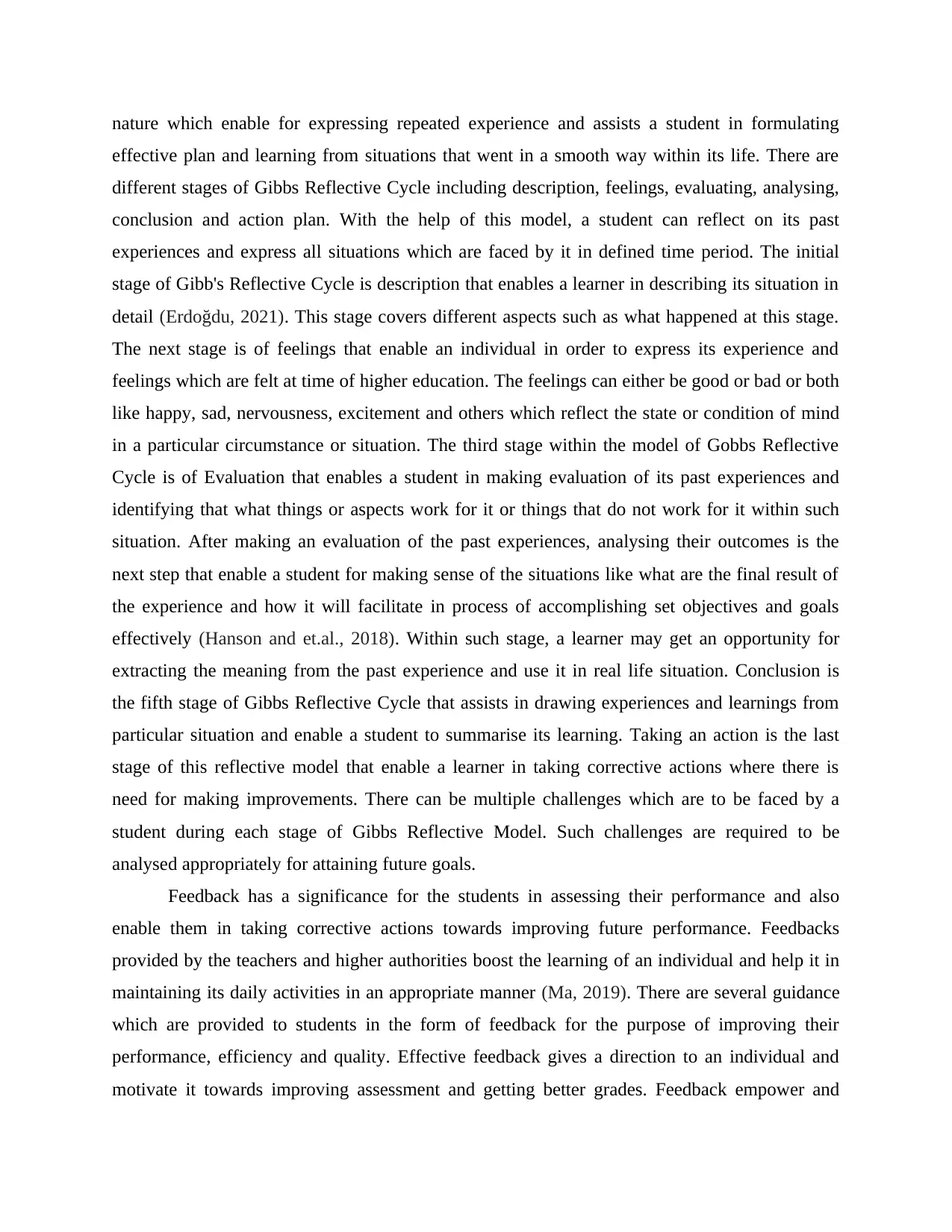
nature which enable for expressing repeated experience and assists a student in formulating
effective plan and learning from situations that went in a smooth way within its life. There are
different stages of Gibbs Reflective Cycle including description, feelings, evaluating, analysing,
conclusion and action plan. With the help of this model, a student can reflect on its past
experiences and express all situations which are faced by it in defined time period. The initial
stage of Gibb's Reflective Cycle is description that enables a learner in describing its situation in
detail (Erdoğdu, 2021). This stage covers different aspects such as what happened at this stage.
The next stage is of feelings that enable an individual in order to express its experience and
feelings which are felt at time of higher education. The feelings can either be good or bad or both
like happy, sad, nervousness, excitement and others which reflect the state or condition of mind
in a particular circumstance or situation. The third stage within the model of Gobbs Reflective
Cycle is of Evaluation that enables a student in making evaluation of its past experiences and
identifying that what things or aspects work for it or things that do not work for it within such
situation. After making an evaluation of the past experiences, analysing their outcomes is the
next step that enable a student for making sense of the situations like what are the final result of
the experience and how it will facilitate in process of accomplishing set objectives and goals
effectively (Hanson and et.al., 2018). Within such stage, a learner may get an opportunity for
extracting the meaning from the past experience and use it in real life situation. Conclusion is
the fifth stage of Gibbs Reflective Cycle that assists in drawing experiences and learnings from
particular situation and enable a student to summarise its learning. Taking an action is the last
stage of this reflective model that enable a learner in taking corrective actions where there is
need for making improvements. There can be multiple challenges which are to be faced by a
student during each stage of Gibbs Reflective Model. Such challenges are required to be
analysed appropriately for attaining future goals.
Feedback has a significance for the students in assessing their performance and also
enable them in taking corrective actions towards improving future performance. Feedbacks
provided by the teachers and higher authorities boost the learning of an individual and help it in
maintaining its daily activities in an appropriate manner (Ma, 2019). There are several guidance
which are provided to students in the form of feedback for the purpose of improving their
performance, efficiency and quality. Effective feedback gives a direction to an individual and
motivate it towards improving assessment and getting better grades. Feedback empower and
effective plan and learning from situations that went in a smooth way within its life. There are
different stages of Gibbs Reflective Cycle including description, feelings, evaluating, analysing,
conclusion and action plan. With the help of this model, a student can reflect on its past
experiences and express all situations which are faced by it in defined time period. The initial
stage of Gibb's Reflective Cycle is description that enables a learner in describing its situation in
detail (Erdoğdu, 2021). This stage covers different aspects such as what happened at this stage.
The next stage is of feelings that enable an individual in order to express its experience and
feelings which are felt at time of higher education. The feelings can either be good or bad or both
like happy, sad, nervousness, excitement and others which reflect the state or condition of mind
in a particular circumstance or situation. The third stage within the model of Gobbs Reflective
Cycle is of Evaluation that enables a student in making evaluation of its past experiences and
identifying that what things or aspects work for it or things that do not work for it within such
situation. After making an evaluation of the past experiences, analysing their outcomes is the
next step that enable a student for making sense of the situations like what are the final result of
the experience and how it will facilitate in process of accomplishing set objectives and goals
effectively (Hanson and et.al., 2018). Within such stage, a learner may get an opportunity for
extracting the meaning from the past experience and use it in real life situation. Conclusion is
the fifth stage of Gibbs Reflective Cycle that assists in drawing experiences and learnings from
particular situation and enable a student to summarise its learning. Taking an action is the last
stage of this reflective model that enable a learner in taking corrective actions where there is
need for making improvements. There can be multiple challenges which are to be faced by a
student during each stage of Gibbs Reflective Model. Such challenges are required to be
analysed appropriately for attaining future goals.
Feedback has a significance for the students in assessing their performance and also
enable them in taking corrective actions towards improving future performance. Feedbacks
provided by the teachers and higher authorities boost the learning of an individual and help it in
maintaining its daily activities in an appropriate manner (Ma, 2019). There are several guidance
which are provided to students in the form of feedback for the purpose of improving their
performance, efficiency and quality. Effective feedback gives a direction to an individual and
motivate it towards improving assessment and getting better grades. Feedback empower and
Paraphrase This Document
Need a fresh take? Get an instant paraphrase of this document with our AI Paraphraser
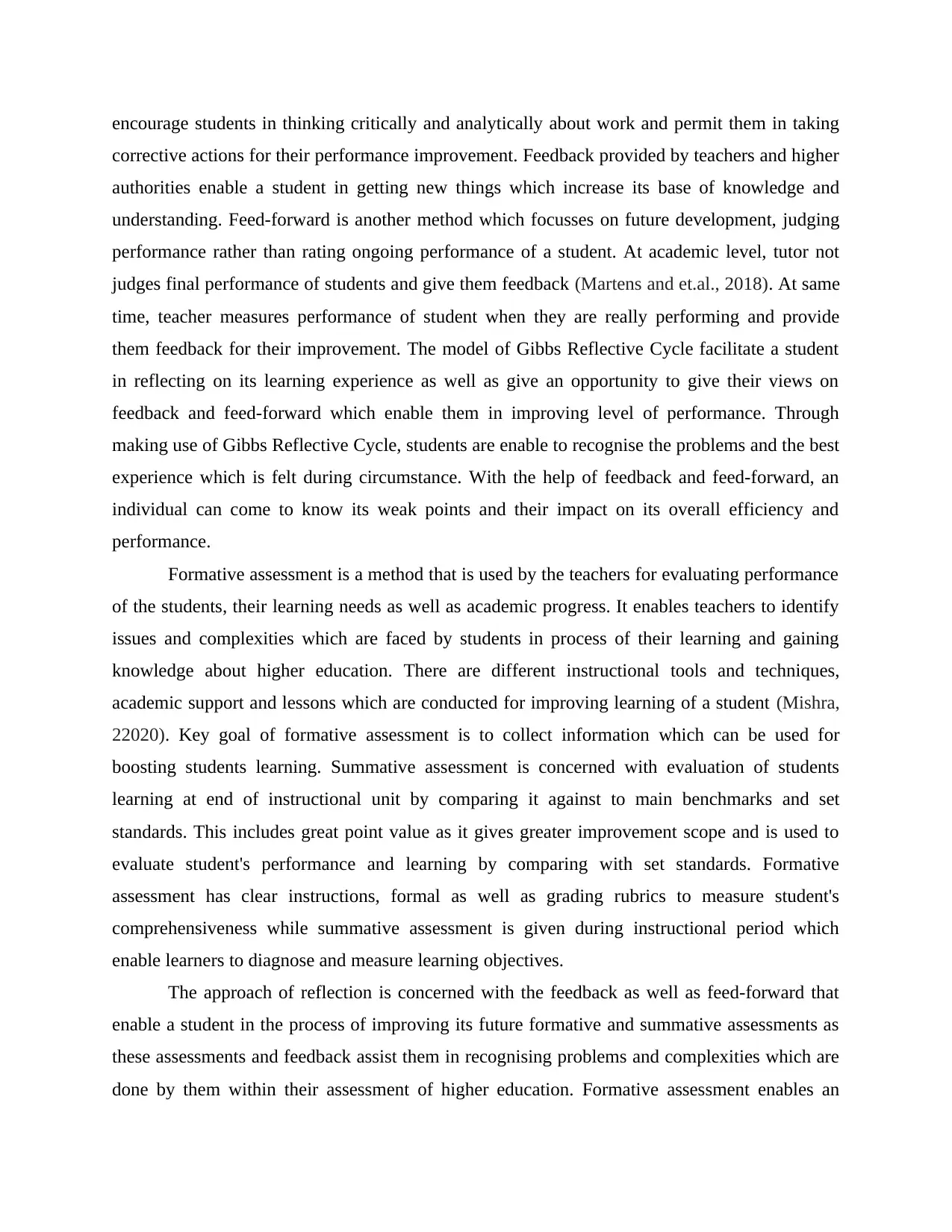
encourage students in thinking critically and analytically about work and permit them in taking
corrective actions for their performance improvement. Feedback provided by teachers and higher
authorities enable a student in getting new things which increase its base of knowledge and
understanding. Feed-forward is another method which focusses on future development, judging
performance rather than rating ongoing performance of a student. At academic level, tutor not
judges final performance of students and give them feedback (Martens and et.al., 2018). At same
time, teacher measures performance of student when they are really performing and provide
them feedback for their improvement. The model of Gibbs Reflective Cycle facilitate a student
in reflecting on its learning experience as well as give an opportunity to give their views on
feedback and feed-forward which enable them in improving level of performance. Through
making use of Gibbs Reflective Cycle, students are enable to recognise the problems and the best
experience which is felt during circumstance. With the help of feedback and feed-forward, an
individual can come to know its weak points and their impact on its overall efficiency and
performance.
Formative assessment is a method that is used by the teachers for evaluating performance
of the students, their learning needs as well as academic progress. It enables teachers to identify
issues and complexities which are faced by students in process of their learning and gaining
knowledge about higher education. There are different instructional tools and techniques,
academic support and lessons which are conducted for improving learning of a student (Mishra,
22020). Key goal of formative assessment is to collect information which can be used for
boosting students learning. Summative assessment is concerned with evaluation of students
learning at end of instructional unit by comparing it against to main benchmarks and set
standards. This includes great point value as it gives greater improvement scope and is used to
evaluate student's performance and learning by comparing with set standards. Formative
assessment has clear instructions, formal as well as grading rubrics to measure student's
comprehensiveness while summative assessment is given during instructional period which
enable learners to diagnose and measure learning objectives.
The approach of reflection is concerned with the feedback as well as feed-forward that
enable a student in the process of improving its future formative and summative assessments as
these assessments and feedback assist them in recognising problems and complexities which are
done by them within their assessment of higher education. Formative assessment enables an
corrective actions for their performance improvement. Feedback provided by teachers and higher
authorities enable a student in getting new things which increase its base of knowledge and
understanding. Feed-forward is another method which focusses on future development, judging
performance rather than rating ongoing performance of a student. At academic level, tutor not
judges final performance of students and give them feedback (Martens and et.al., 2018). At same
time, teacher measures performance of student when they are really performing and provide
them feedback for their improvement. The model of Gibbs Reflective Cycle facilitate a student
in reflecting on its learning experience as well as give an opportunity to give their views on
feedback and feed-forward which enable them in improving level of performance. Through
making use of Gibbs Reflective Cycle, students are enable to recognise the problems and the best
experience which is felt during circumstance. With the help of feedback and feed-forward, an
individual can come to know its weak points and their impact on its overall efficiency and
performance.
Formative assessment is a method that is used by the teachers for evaluating performance
of the students, their learning needs as well as academic progress. It enables teachers to identify
issues and complexities which are faced by students in process of their learning and gaining
knowledge about higher education. There are different instructional tools and techniques,
academic support and lessons which are conducted for improving learning of a student (Mishra,
22020). Key goal of formative assessment is to collect information which can be used for
boosting students learning. Summative assessment is concerned with evaluation of students
learning at end of instructional unit by comparing it against to main benchmarks and set
standards. This includes great point value as it gives greater improvement scope and is used to
evaluate student's performance and learning by comparing with set standards. Formative
assessment has clear instructions, formal as well as grading rubrics to measure student's
comprehensiveness while summative assessment is given during instructional period which
enable learners to diagnose and measure learning objectives.
The approach of reflection is concerned with the feedback as well as feed-forward that
enable a student in the process of improving its future formative and summative assessments as
these assessments and feedback assist them in recognising problems and complexities which are
done by them within their assessment of higher education. Formative assessment enables an
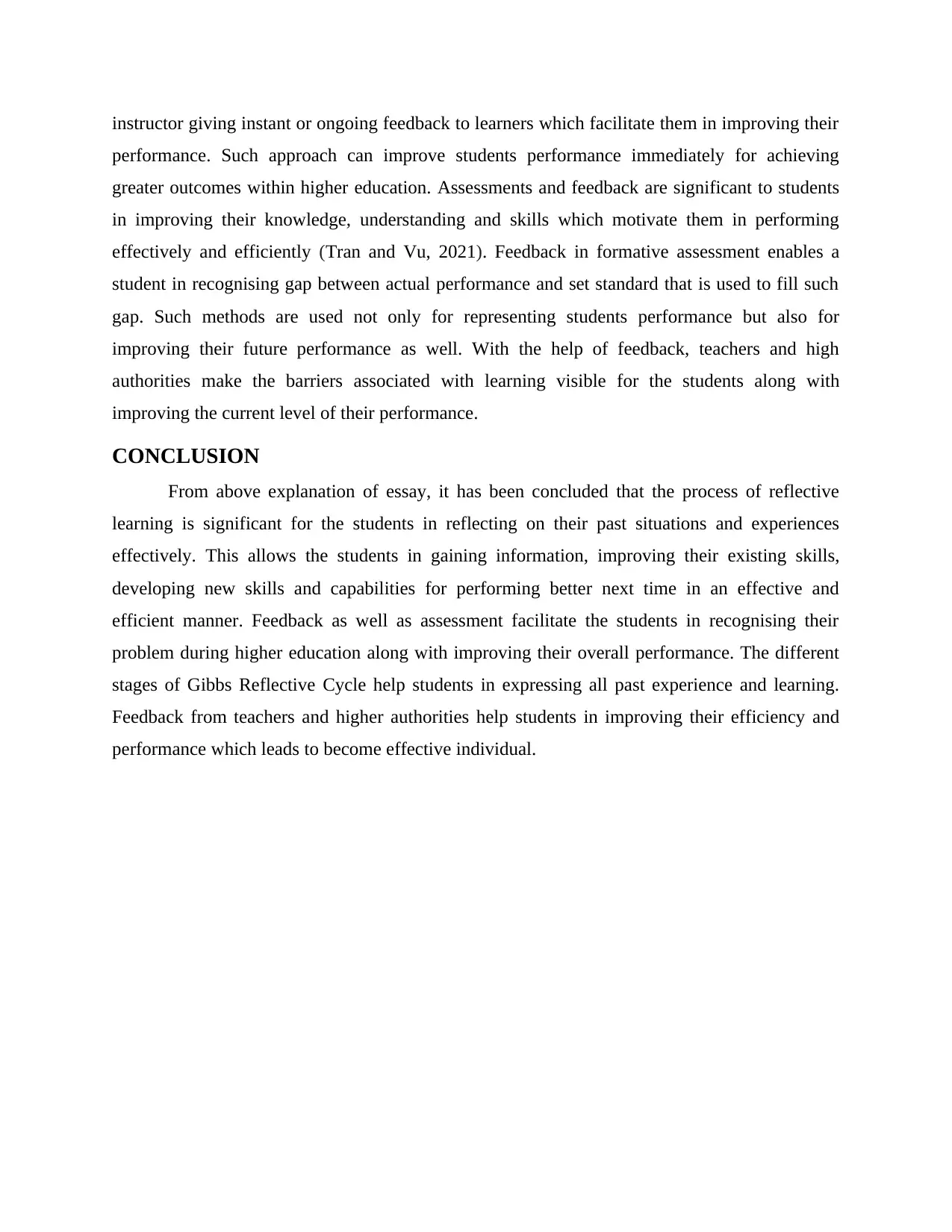
instructor giving instant or ongoing feedback to learners which facilitate them in improving their
performance. Such approach can improve students performance immediately for achieving
greater outcomes within higher education. Assessments and feedback are significant to students
in improving their knowledge, understanding and skills which motivate them in performing
effectively and efficiently (Tran and Vu, 2021). Feedback in formative assessment enables a
student in recognising gap between actual performance and set standard that is used to fill such
gap. Such methods are used not only for representing students performance but also for
improving their future performance as well. With the help of feedback, teachers and high
authorities make the barriers associated with learning visible for the students along with
improving the current level of their performance.
CONCLUSION
From above explanation of essay, it has been concluded that the process of reflective
learning is significant for the students in reflecting on their past situations and experiences
effectively. This allows the students in gaining information, improving their existing skills,
developing new skills and capabilities for performing better next time in an effective and
efficient manner. Feedback as well as assessment facilitate the students in recognising their
problem during higher education along with improving their overall performance. The different
stages of Gibbs Reflective Cycle help students in expressing all past experience and learning.
Feedback from teachers and higher authorities help students in improving their efficiency and
performance which leads to become effective individual.
performance. Such approach can improve students performance immediately for achieving
greater outcomes within higher education. Assessments and feedback are significant to students
in improving their knowledge, understanding and skills which motivate them in performing
effectively and efficiently (Tran and Vu, 2021). Feedback in formative assessment enables a
student in recognising gap between actual performance and set standard that is used to fill such
gap. Such methods are used not only for representing students performance but also for
improving their future performance as well. With the help of feedback, teachers and high
authorities make the barriers associated with learning visible for the students along with
improving the current level of their performance.
CONCLUSION
From above explanation of essay, it has been concluded that the process of reflective
learning is significant for the students in reflecting on their past situations and experiences
effectively. This allows the students in gaining information, improving their existing skills,
developing new skills and capabilities for performing better next time in an effective and
efficient manner. Feedback as well as assessment facilitate the students in recognising their
problem during higher education along with improving their overall performance. The different
stages of Gibbs Reflective Cycle help students in expressing all past experience and learning.
Feedback from teachers and higher authorities help students in improving their efficiency and
performance which leads to become effective individual.
⊘ This is a preview!⊘
Do you want full access?
Subscribe today to unlock all pages.

Trusted by 1+ million students worldwide
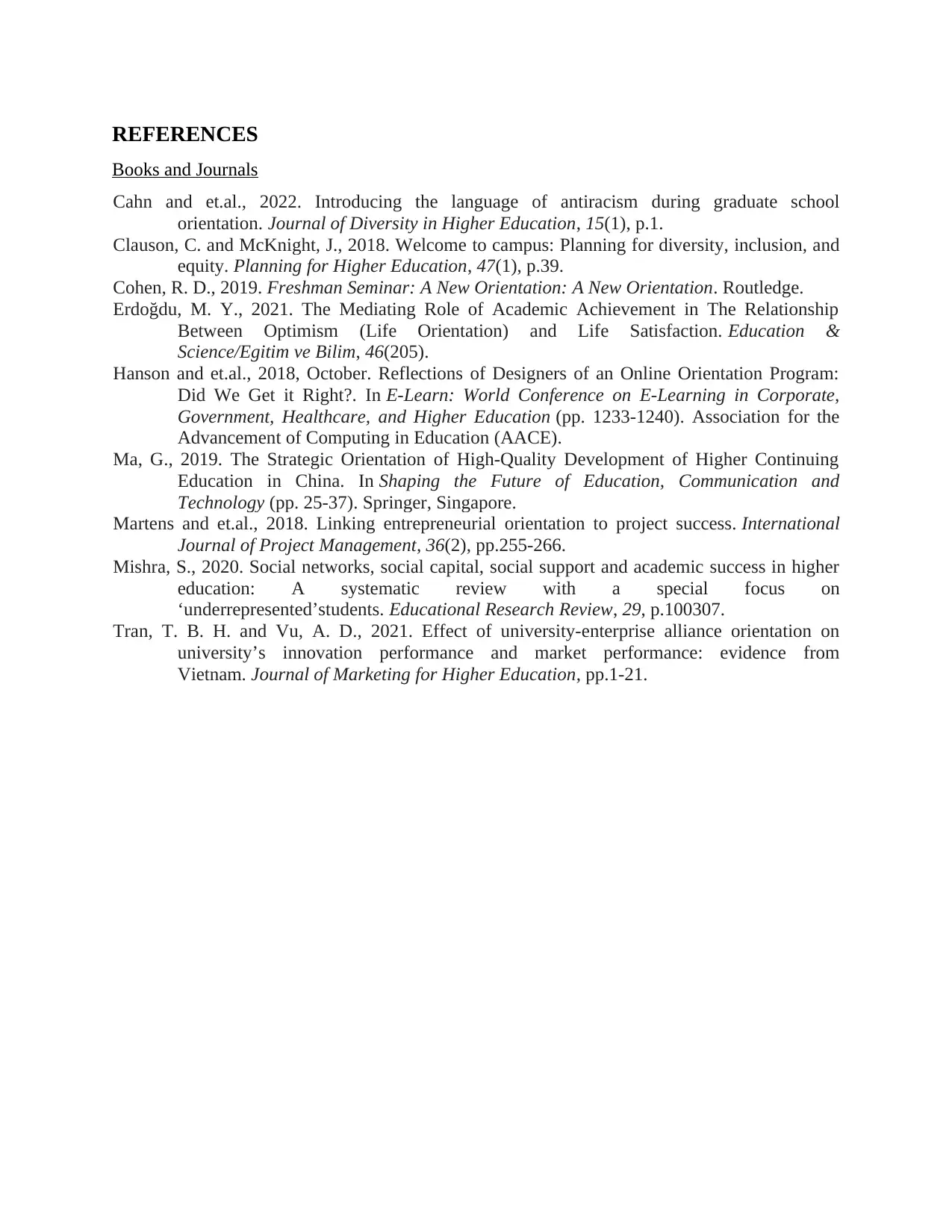
REFERENCES
Books and Journals
Cahn and et.al., 2022. Introducing the language of antiracism during graduate school
orientation. Journal of Diversity in Higher Education, 15(1), p.1.
Clauson, C. and McKnight, J., 2018. Welcome to campus: Planning for diversity, inclusion, and
equity. Planning for Higher Education, 47(1), p.39.
Cohen, R. D., 2019. Freshman Seminar: A New Orientation: A New Orientation. Routledge.
Erdoğdu, M. Y., 2021. The Mediating Role of Academic Achievement in The Relationship
Between Optimism (Life Orientation) and Life Satisfaction. Education &
Science/Egitim ve Bilim, 46(205).
Hanson and et.al., 2018, October. Reflections of Designers of an Online Orientation Program:
Did We Get it Right?. In E-Learn: World Conference on E-Learning in Corporate,
Government, Healthcare, and Higher Education (pp. 1233-1240). Association for the
Advancement of Computing in Education (AACE).
Ma, G., 2019. The Strategic Orientation of High-Quality Development of Higher Continuing
Education in China. In Shaping the Future of Education, Communication and
Technology (pp. 25-37). Springer, Singapore.
Martens and et.al., 2018. Linking entrepreneurial orientation to project success. International
Journal of Project Management, 36(2), pp.255-266.
Mishra, S., 2020. Social networks, social capital, social support and academic success in higher
education: A systematic review with a special focus on
‘underrepresented’students. Educational Research Review, 29, p.100307.
Tran, T. B. H. and Vu, A. D., 2021. Effect of university-enterprise alliance orientation on
university’s innovation performance and market performance: evidence from
Vietnam. Journal of Marketing for Higher Education, pp.1-21.
Books and Journals
Cahn and et.al., 2022. Introducing the language of antiracism during graduate school
orientation. Journal of Diversity in Higher Education, 15(1), p.1.
Clauson, C. and McKnight, J., 2018. Welcome to campus: Planning for diversity, inclusion, and
equity. Planning for Higher Education, 47(1), p.39.
Cohen, R. D., 2019. Freshman Seminar: A New Orientation: A New Orientation. Routledge.
Erdoğdu, M. Y., 2021. The Mediating Role of Academic Achievement in The Relationship
Between Optimism (Life Orientation) and Life Satisfaction. Education &
Science/Egitim ve Bilim, 46(205).
Hanson and et.al., 2018, October. Reflections of Designers of an Online Orientation Program:
Did We Get it Right?. In E-Learn: World Conference on E-Learning in Corporate,
Government, Healthcare, and Higher Education (pp. 1233-1240). Association for the
Advancement of Computing in Education (AACE).
Ma, G., 2019. The Strategic Orientation of High-Quality Development of Higher Continuing
Education in China. In Shaping the Future of Education, Communication and
Technology (pp. 25-37). Springer, Singapore.
Martens and et.al., 2018. Linking entrepreneurial orientation to project success. International
Journal of Project Management, 36(2), pp.255-266.
Mishra, S., 2020. Social networks, social capital, social support and academic success in higher
education: A systematic review with a special focus on
‘underrepresented’students. Educational Research Review, 29, p.100307.
Tran, T. B. H. and Vu, A. D., 2021. Effect of university-enterprise alliance orientation on
university’s innovation performance and market performance: evidence from
Vietnam. Journal of Marketing for Higher Education, pp.1-21.
1 out of 7
Related Documents
Your All-in-One AI-Powered Toolkit for Academic Success.
+13062052269
info@desklib.com
Available 24*7 on WhatsApp / Email
![[object Object]](/_next/static/media/star-bottom.7253800d.svg)
Unlock your academic potential
Copyright © 2020–2025 A2Z Services. All Rights Reserved. Developed and managed by ZUCOL.

